Different Guitar Picks Different Sounds – Pick What You Like
Author: Lucas Frost
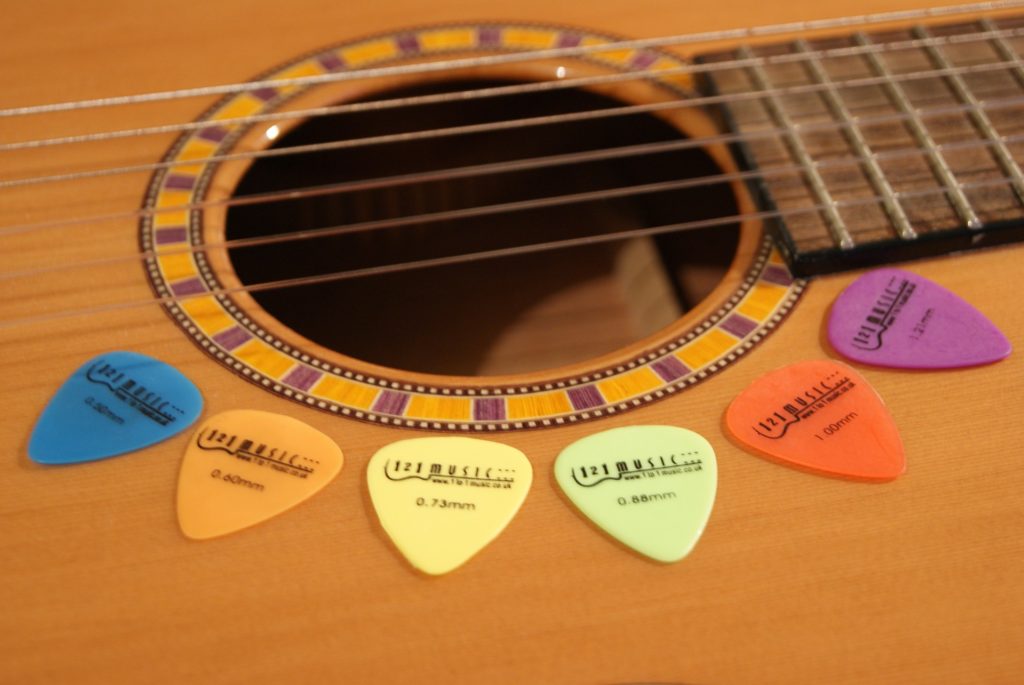
Ahhh, the Guitar picks… From reading some of my other articles, you may get the impression that I don’t much like these pieces of plastic. That is only half-true: in reality, I rely on them so much that my fingerpicking has suffered; you might call it a love-hate thing.
But really, Guitar picks have many advantages – in general, they help you:
- play faster
- play louder, or at least increase your maximum volume – this has obvious advantages for acoustic players, but also gives you a greater dynamic range, even when playing electric.
- sharpen your tone, making it brighter and pointier, and access the taught, brittle timbres which you get playing closer to the bridge
- add “oompf” and pazzaz, because you can more effectively put the weight of your whole arm into strumming and picking
But with so many to choose from, which picks should you get?
Table of Contents
Shape and size
A pick can be thought of as having two sections:
- a comfortable surface to hold the pick securely (broad and with good grip)
- a flat, pointy section to strike the strings
The standard pick shape, broadly an elongated triangle with very rounded edges, is designed to be held at the rounder end between thumb and index finger, using the pointier end to hit the strings. Chloe gives us a more detailed lesson in another article. And although this is the most popular and iconic shape, there are plenty more…
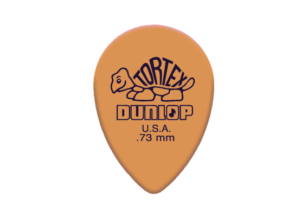 One of my teachers was a Jazz guitarist, and he had one of these tiny “Teadrop” picks. He said it gave him more control over his playing, a more direct connection to the strings. It is true that many technical players, from progressive, metal and jazz styles play teardrop shapes, including the famous Jazz III pick made by Jim Dunlop. Other players such as me find them fiddly to hold – their smallness pops out of my hand when it gets sweaty. This is probably why some guitarists, even really fast ones, go for big picks. The largest one is the Fender Triangle, played by the likes of Daron Malakian from System of a Down. But then again, he often plays a baritone guitar with heavier gauge strings – and larger picks are also popular with bass-players.
One of my teachers was a Jazz guitarist, and he had one of these tiny “Teadrop” picks. He said it gave him more control over his playing, a more direct connection to the strings. It is true that many technical players, from progressive, metal and jazz styles play teardrop shapes, including the famous Jazz III pick made by Jim Dunlop. Other players such as me find them fiddly to hold – their smallness pops out of my hand when it gets sweaty. This is probably why some guitarists, even really fast ones, go for big picks. The largest one is the Fender Triangle, played by the likes of Daron Malakian from System of a Down. But then again, he often plays a baritone guitar with heavier gauge strings – and larger picks are also popular with bass-players.
Thickness is an element of the shape which is also very important. Most picks will have their thickness printed on them: say 0.53mm, which is a fairly “light” plectrum. They are often favoured for strumming work, or for a more delicate, trebly tone. However, thin picks are not ideal for control, as they often bend and flick in unintended ways.
On the opposite end of the spectrum, thicker picks yield a fuller, rounder and heavier tone, and help to articulate notes more precisely. Jazz players and fast metal players gravitate towards these, as both the round, full-end tone and speed appeals to them.
In general, thinner striking surface (in other words, thin and pointy) will emphasize higher frequencies and give a more trebly tone; to get those lower overtones to vibrate, you need a thicker, rounder pick. Think about it: when you play with the fleshy part of your thumb it sounds muffled, much darker than with your fingernail. The same principle applies, and it becomes a question of finding the balance of tone that is right for you, and combining it with a shape that you find comfortable to hold.
Learn to play Guitar on your mobile, download the free Uberchord App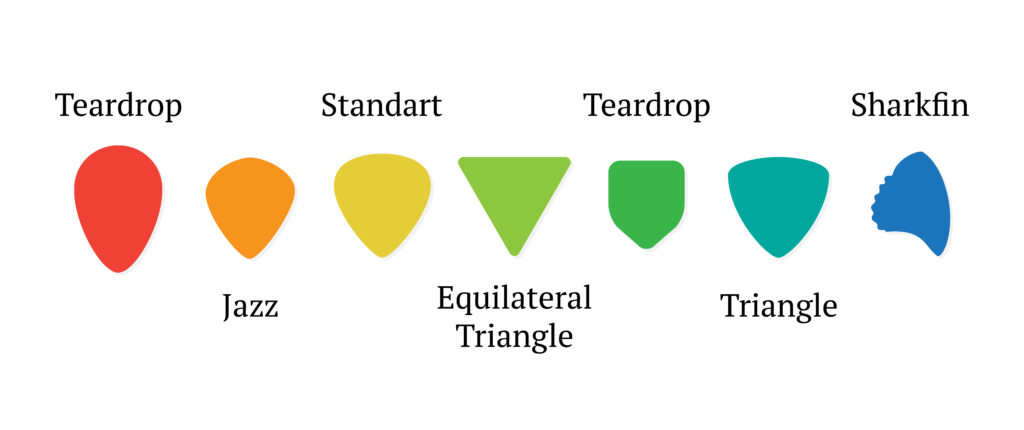
Material and texture
What the pick is made of is equally important. The material (usually a plastic of some sort) influences:
- the pick’s flexibility, which is related to control, playability and playing style (often, rhythm players like flexible picks)
- the level of grip when things get sweaty and slippery up on stage – slippery materials often compensate by adding some texture to the pick
- the durability
- the “release” – basically how easily it glides off the string. More “slippery” picks tend to give a cleaner, more pure tone, while the “rougher” ones will add more colour
- the “memory” – this refers to the extent the pick gets worn down by the strings and becomes literally shaped to the guitarist’s playing style.
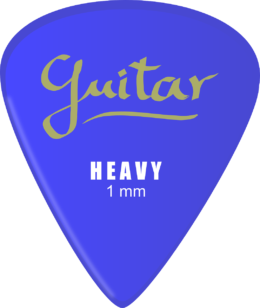 Nylon was one of the first materials to become popular. Used by the likes of Jimmy Page, nylon is smooth, its slick surface perfect for a clear, bright, vintage sound. As it can be made very thin, it is frequently used for light-weight picks. Often these picks have a textured surface to keep them from slipping out of player’s hands.
Nylon was one of the first materials to become popular. Used by the likes of Jimmy Page, nylon is smooth, its slick surface perfect for a clear, bright, vintage sound. As it can be made very thin, it is frequently used for light-weight picks. Often these picks have a textured surface to keep them from slipping out of player’s hands.
Celluloid is another fairly vintage pick, being one of the first materials to be used. Similar to nylon, it has an almost “oily” texture, which makes it fast and slick for a clean tone.
Tortex is another very popular material, and my personal favourite. It has a matte surface and sort of powdery texture, providing good grip on the fingers as well as a darker, more solid tone. It also has high “memory”, and will mold itself to your playing after a couple of days of intense riffing. It started off as a replacement for actual turtle shell, which was banned in 1973 to protect its endangered producer, the Hawksbill turtle.
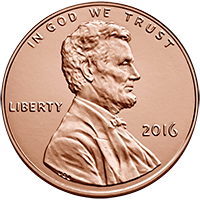 Of course there are also other materials: harder ones, like glass, (semi-precious) stone and porcelain give a more focused, clear tone, and often a more beautiful and precious pick. And metal picks too – you have probably played with a coin, like Queen guitarist Brian May. He likes the tight response the hard surface gives him on the strings, and the rounder striking surface adds some colour to the tone. On the other side, there are also softer picks made from leather, felt or wood. These produce a rounder tone with softer attack, often used for strumming or warmer sounds. And there are composite picks; for instance the Dava picks, which have a sleek nylon striking zone and an easy-to-grip rubber holding zone – the best of both worlds.
Of course there are also other materials: harder ones, like glass, (semi-precious) stone and porcelain give a more focused, clear tone, and often a more beautiful and precious pick. And metal picks too – you have probably played with a coin, like Queen guitarist Brian May. He likes the tight response the hard surface gives him on the strings, and the rounder striking surface adds some colour to the tone. On the other side, there are also softer picks made from leather, felt or wood. These produce a rounder tone with softer attack, often used for strumming or warmer sounds. And there are composite picks; for instance the Dava picks, which have a sleek nylon striking zone and an easy-to-grip rubber holding zone – the best of both worlds.
Style
Let us not deny it: picks also have other purposes, the most obvious one being style. Many of us might have a pretty pick with a picture of Bob Marley on it, or have one dangling around our neck as a fashion accessory, a statement that says “I’m a guitarist”. It is almost like belonging to a tribe. And you know, that’s legit, and probably you will take the pick’s coolness into account.
The famous Sharkfin picks fall into this category. No doubt it is a great pick, apparently used by The Beatles and The Beach Boys. They have three different striking surfaces (pointy, rounder and textured) for different tonal responses, as well as a concave side which you can use to slot the pick under your finger while you do some fingerpicking. But most of all, the Sharkfin is a cool “designer” pick. The one I bought when I was 15 even had a hole to put it on a necklace.
And on a lighter note, because they are so cheap, they are like a guilt-free ticket into a guitar shop. I still love going into music shops, trying out guitars for ages, and then leaving after just buying a couple of picks: my favourite and another new one to try out.
So, which pick is right for you?
With so many options out there, it can be hard. Either you know what style you want to play, in which case you can ask a guy at a music shop, or take the guidelines in this post to get an idea, depending on the tone and playing feel you are after. If I had to recommend any, I’d suggest check out Jim Dunlop plectrums or Gravity Picks, if you like something special and exclusive.
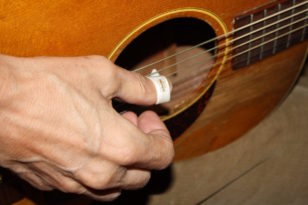 But if you are reading this article, the chances are you don’t know that yet. So my advice is: go with your gut. At the end of the day, the plectrum you pick (pun very much intended) ends up being more of an emotional choice – does it feel like yours, can you identify with it, does it sound like you? This matters more than the precise density of the material or the exact angle at which the point is shaped. And they are cheap, so try out! For example, have you ever tried a thumbpick?
But if you are reading this article, the chances are you don’t know that yet. So my advice is: go with your gut. At the end of the day, the plectrum you pick (pun very much intended) ends up being more of an emotional choice – does it feel like yours, can you identify with it, does it sound like you? This matters more than the precise density of the material or the exact angle at which the point is shaped. And they are cheap, so try out! For example, have you ever tried a thumbpick?
Need a video instruction on pick comparison? Check out Phil Ockelford explaining different picks and their effect on tones.
Are you aching to test our new knowledge on some new riffs and chord progressions? Having the right guitar pick can have a very surprising effect on your playing. We suggest you take a look at passenger let her go guitar notes, the key of dm for guitar, and the best youtube guitar lessons for rock.




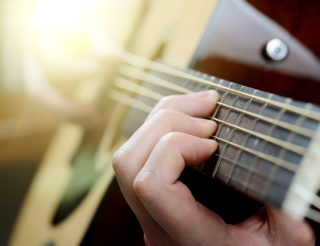
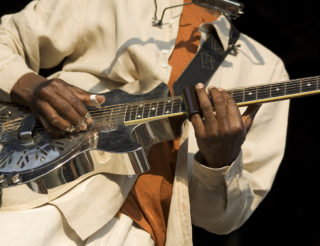


Thanks for this great piece!
I am a guitar teacher and I usually refer my beginner students to this webpage as I find it really useful to teach them how to choose the right pick for them and what they will sound like.
Thanks so much
Justin
http://guitarpickzone.com/best-guitar-picks/
Hi. This is the second thing on guitar picks that I read today. and thank goodness it’s someone knows what they’re talking about. the other one was full of mistakes and misleading information. When someone is a beginner, things are very touchy and important. Misinformation could be damaging for a new player.
So thank you for having your information correct. There’s one thing you didn’t really mention if you don’t mind me saying.
The thinner a pick, the faster you can strum. But the sinner you go your pic will also hit the strings with less attack. So although you might be able to blast off some blisteringly fast rhythm, your sound will be weak and not satisfying. If you have a super thick pick, strumming really fast would be difficult, and at the same time, it would be a solid sound with lots of attack.
I prefer a medium pick which not only has a good strong and solid sound, but it will be fast enough to be able to express myself.
The Best of both worlds so to speak.
And one of the most important things I ever learned about pics is how hard you hold it… “You gotta be loose” one of my associates would say. I actually took me years to really know what he was talking about…
By holding the pick with relaxed fingers is so beneficial. Holding it loose. Just enough so you know you’re not going to drop it. This way, not only will your guitar stay in tune better for longer, but you will find that it is more expressionate. Keep it loose!
Anyway, individual who wrote this, I praise you for your sharing of good information. It is so important to be truthful in this world, and unfortunately, some people just don’t get it. It’s really their loss….. Blessing and peace!